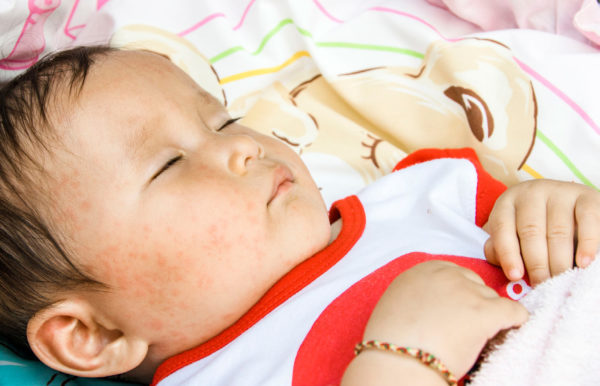Roseola is a mild viral infection that causes high fever followed by a rash. It generally infects children between the ages of 6 months and 2 years.

What Causes Roseola?
Two types of closely related viruses cause roseola. Human herpesvirus (HHV) type 6 and type 7 can each cause roseola. While these viruses are in the herpes simplex category, they do not cause cold sores or genital herpes. It usually takes a week to 10 days for roseola symptoms to appear after exposure to the virus.
Symptoms of Roseola
Some babies may contract roseola and never have symptoms. However, most babies will have:
- A high fever,
- A slightly sore throat,
- Runny nose,
- Irritability,
- Decreased appetite,
- Mild diarrhea,
- Slight cough,
- Swollen lymph glands.
The fever usually lasts for three to five days. After the fever subsides, a rash appears on the child’s body. The rash looks like small pink spots or patches, and is flat or very slightly raised. For most children, the rash starts on the chest or back before spreading to the neck and arms. It usually doesn’t reach the face or legs.
The rash may last a few hours or a few days.
Should I Take My Baby to a Doctor?
Most cases of roseola can be treated at home. Use acetaminophen or ibuprofen to treat fevers or irritability. The rash usually isn’t bothersome.
Babies who need to see a doctor include those who:
- Have fevers of greater than 103â,
- Have roseola and a fever that lasts more than seven days,
- Still have a rash after three days.
A small percentage of babies with roseola can experience febrile seizures caused by the high fevers. Symptoms include unconsciousness, loss of bladder or bowel control and/or twitching in the extremities or face. These babies need immediate medical attention.
Doctors should also see babies with weakened immune systems for appropriate treatment of roseola.
Can I Prevent Roseola?
Unfortunately, roseola is a highly contagious virus that can be easily spread among children. There is no vaccine. Prevent its spread with frequent hand washing, limiting contact with sick people and washing toys and pacifiers often.
